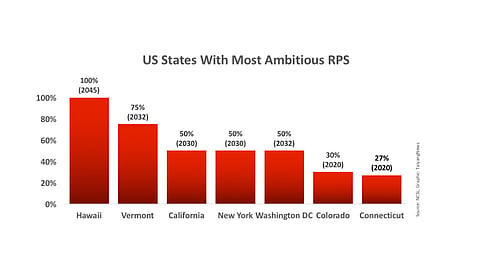

The District of Columbia (DC) in the US has increased its renewable portfolio standard (RPS) to 50% by 2032, from the earlier target of 20% by 2020. Under the Renewable Portfolio Standard Expansion Amendment Act of 2016, the district will also add 5% of solar power by the same year.
Under the new act, Washington DC will reduce its greenhouse gas emissions by 50% and increase the share of renewables by 50% of the district's energy supply by 2032. DC Mayor Muriel E. Bowser signed the new act on July 25. She said, "We will serve 100,000 low-income households by 2032 — that's more than 6,000 homes per year, and we'll reduce their electricity bills by 50%, as a result. We'll be creating at least 100 green jobs in the first year, with that number growing every year through 2032. That means reducing carbon emissions, lowering residents' energy bills, and providing pathways to the middle class through the burgeoning marketplace of clean energy – all at the same time."
Expecting an increase in the demand for solar power with the new law in place, the district has plans to train people to enter the solar installation sector with training provided by GZEP Solar Plus, a joint initiative of the Department of Energy and Environment (DOEE), GRID Alternatives Mid-Atlantic and Marion Barry Summer Youth Employment Program (MBSYEP). Under this program, people in the age group of 18 to 24 will be trained in solar panel installation, energy efficiency and basic safety and construction skills.
DOEE Director Tommy Wells, said, "This week's extreme heat and our volatile weather, including last week's hail storm and this winter's blizzard, are examples of the impacts climate change will continue to have on our city and the planet." He added, "The Renewable Portfolio Standard bill expands the set of tools we need to address and mitigate the effects of climate change in the District and will help keep us on track to meet our Sustainable DC goals to reduce greenhouse gas emissions by 50% and to ensure renewables make up at least 50% of the District's energy supply by 2032."
In the US, Iowa was the first state to have a RPS target in 1983. Leading the tally of states with the most ambitious RPS in the country is Hawaii with a 100% target by 2045, Vermont with 75% by 2032, California and New York 50% by 2030, Colorado with 30% by 2020 and Connecticut with 27% by 2020. The country has been taking giant strides to push the cause of renewables. Last year, President Obama announced his Clean Power Plan under which the country will increase its power generation from renewables to 28% by 2030.
According to a March 2016 analysis by the National Conference of State Legislatures (NCSL), renewable energy policies help states in the US drive the renewable energy market worth $36 billion.
The newly signed legislation is slated to become effective after the Congressional review period.
